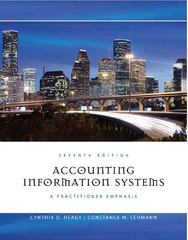Question
I could use a bit of assistance on this assignment. Number 2 has me stumped! 1. Begin with an introduction to the organization. Identify its
I could use a bit of assistance on this assignment. Number 2 has me stumped!
1. Begin with an introduction to the organization. Identify its manufacturing segment. Detail briefly the products manufactured by your organization, the companys market niche and/or customer base.
2. Identify significant costs in your organization. Some of the mandatory topics to research and present about your organization would include, but not be limited to: (a) costs associated with environmental concerns, (b) cost behavior, (c) prevention costs, (d) appraisal (detection) costs, (e) internal failure costs, or (f) external failure costs.
3. Include a section devoted to Cost-Volume-Profit Analysis (CVP). Review Chapter 3 in your textbook. The level of detail you include in this section is flexible. But, make sure your analysis is related to actual financial data from the company. Suggested metrics would include the contribution margin, Degree of Operating Leverage (DOL), breakeven point, and others. Remember, it is vital that you determine whether or not you will have access to this information BEFORE you start the project. Otherwise, you may not have time to change organizations later during the course.
4. Discuss budgeting considerations. Include the organizations budget process (for example, is it top-down, or bottom-up), the organizations budget variances and discuss management decisions related to budgeting.
5. Based on independent research and additional textbook readings, create a Balanced Scorecard, incorporating all four of the organizational dimensions (financial, customer, internal business (BSC), and learning and growth). Identify 2 or 3 Strategic Objectives (SO), also known as critical success factors (CSFs) for each category/perspective. Then, evaluate and analyze your organizations performance in relation to these critical success factors. (To help you with this part, review the material found on pages 16 and 17 of the textbook. Additionally, read pages 590 to 599 in the textbook in Chapter 11). NOTE: Do not simply cut and paste a BSC collected from an on-line source. Create your own BSC. Exhibit 11.10 on page 599 of your course text demonstrates the proper BSC format.
6. Create (again, the term create is very important do not simply cut and paste a version collected from an on-line source) a strategy map for your organization. Your organizations strategy map MUST resemble Exhibit 11.9, seen on page 596 of your textbook. Include an explanation for each element in your strategy map. One thing to particularly note The BSC and strategy map must be aligned that is, the SOs must match. Please compare Exhibits 11.9 & 11.10 on pages 596 and 599 in the textbook. Please note that the elements in the BSC & the strategy map are fully coordinated.
7. End with a summary review (A formal Conclusion heading and section is required) of the performance evaluation. Use sub-headings to discuss key strengths and weaknesses of the organization and describe recommendations to be made to the current organizational strategy.
Step by Step Solution
There are 3 Steps involved in it
Step: 1

Get Instant Access to Expert-Tailored Solutions
See step-by-step solutions with expert insights and AI powered tools for academic success
Step: 2

Step: 3

Ace Your Homework with AI
Get the answers you need in no time with our AI-driven, step-by-step assistance
Get Started


